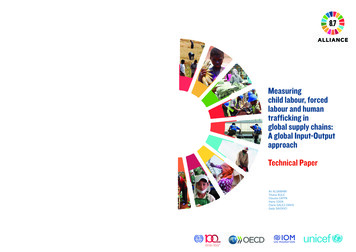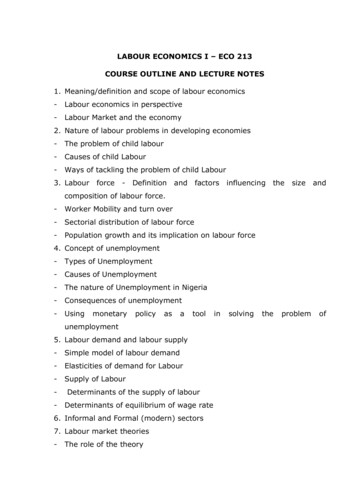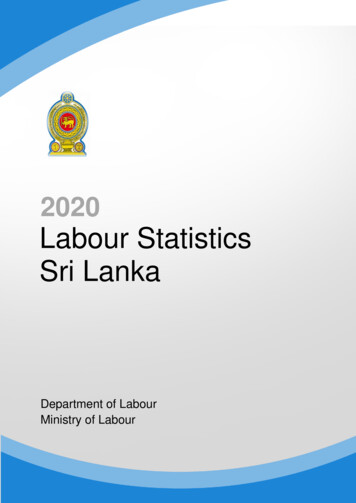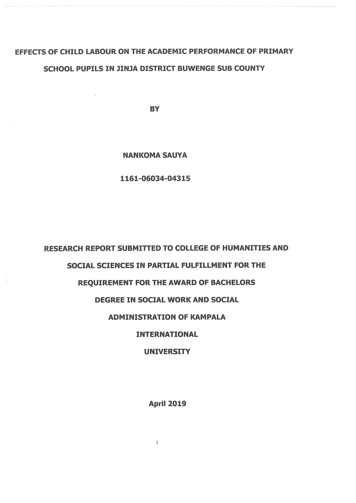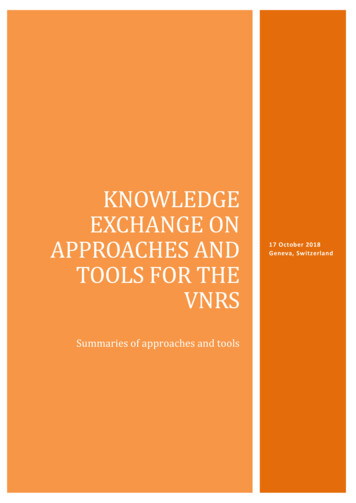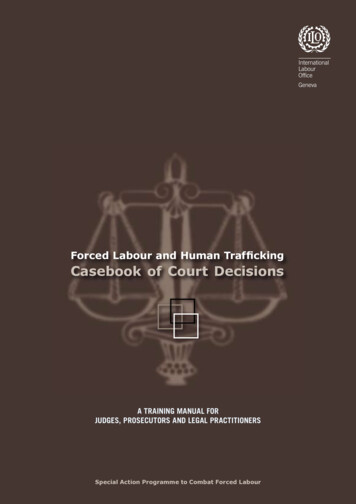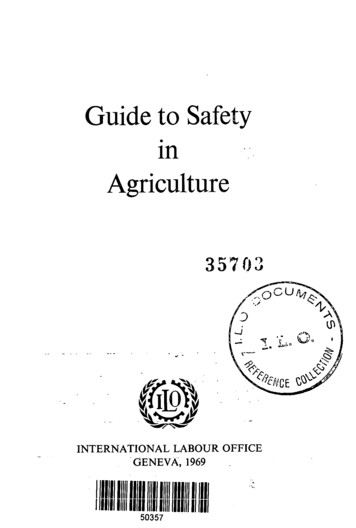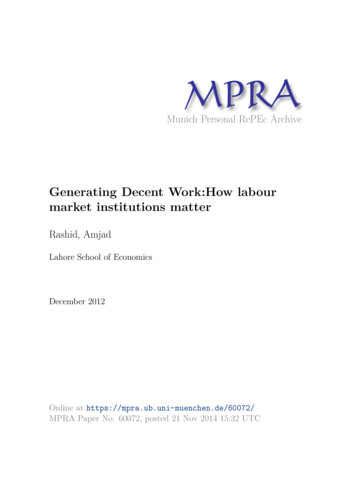
Transcription
Munich Personal RePEc ArchiveGenerating Decent Work:How labourmarket institutions matterRashid, AmjadLahore School of EconomicsDecember 2012Online at https://mpra.ub.uni-muenchen.de/60072/MPRA Paper No. 60072, posted 21 Nov 2014 15:32 UTC
GENERATING DECENT WORK:HOW LABOUR MARKET INSTITUTIONS MATTERDr. Rashid Amjad Director, Graduate Institute of Development Studies, Lahore School of Economics, Lahore.(amjadr@lahoreschool.edu.pk) This paper is an extract of the V.V. Giri Memorial Lecture delivered by theauthor at the Annual Meeting of the Indian Society of Labour Economics (ISLE), held at the BenaresHindu University (BHU), Varanasi, during 20-22 December 2012.
-1-President Giri, who had earlier been the Vice-President of India, a state governor,and Federal Minister including the Minister for Labour, was a truly remarkable son of thesub-continent. He devoted his life to gaining freedom for his country from colonial ruleand to improving the lives of working people. He was a pioneer in the building of theIndian trade union movement, the aim of which was to ensure that workers could livewith dignity and that their basic rights were respected.In order to underscore the commitment of the leaders and people of that generation towork for improving the lives and conditions of working classes, I will also mention herethat the founder of Pakistan and its first Governor-General, Quaid-e-Azam MuhammadAli Jinnah served as elected president of the All-India Postal Staff Union for 1925.This lecture, therefore, focuses on rekindling our forefathers’ spirit of dedication tobuilding a humane and just society in which the rights of working people would beupheld, and their voices heard and respected. At a time when our countries face manychallenges, we must once again erect the pillar of social justice, which appears to beslowly fading from our memories as the pursuit of unbridled economic growth—sadlybased on the economics of greed—takes centre-stage. If we are to live in peace andharmony in a vibrant yet cohesive society, then economic growth with social justice, Iwill argue, is the only viable means of achieving this goal. The theme of this lecture,“Generating Decent Jobs: How Labour Market Institutions Matter”, is a humble attemptto suggest how we can move towards this goal.The fundamental premise of the lecture is that the generation of employment isthe most effective means of ensuring inclusive, sustainable, and equitable growth, butwith the important proviso that this cannot be done through the creation of merely anyjobs, but better jobs in terms of their being productive and remunerative and in which thefundamental rights at work are respected. This means shifting away from a narrow labourmarket-based perspective to one in which both markets and institutions together play animportant role in moving towards an efficient, equitable, and rights-based labour market.I fully realise that in developing countries such as ours, in which a large proportion of theworking people are still employed in the unorganised sector of the economy and the vast
-2majority of the population lives below or just above the poverty line, this shift inemphasis from the creation of new jobs to the creation of better jobs seems almost a leapof faith rather than one based on stark economic realities.I shall, therefore, follow a path that in many ways reflects my own experience, by firstexamining the traditional route taken by economists of identifying factors that encouragemore rapid employment generation as well as the means of overcoming the factors thathinder this growth. I shall then move, as did the International Labour Organisation (ILO)over the last decade, towards examining the more ambitious goal of generating better jobsor what the ILO terms ‘decent work’, while explaining what the concept stands for, itshistorical context, and then the challenge of implementing it in developing countries. Inso doing, I hope I can bring out the real value added by the concept of decent work torealisation of the goal of generating not just more jobs but better jobs—taking asomewhat more realistic view point than the ILO—of how we can move towardsachieving it.I. LABOUR ABSORPTION TO DECENT WORKIn pure economic terms, the process of economic development entails the movement orshift of labour from low-productivity employment or sectors to those with higherproductivity, resulting in the faster growth of output. If this shift can be sustained, then,over time, it makes it possible to improve the economic and social conditions of the widerpopulation. The factors that facilitate this shift from low-productivity to high-productivityjobs and sectors have, therefore, been the focus of development economics, and indeedeconomic growth theories, in general.As the pace of economic development in developing countries over the last five to sixdecades has failed to meet expectations and as, in a number of cases, economicconditions have actually worsened rather than improved, the focus has also shifted torelating economic development directly with poverty, which is measured in manydifferent ways, including overcoming malnutrition, and providing education, healthcare,and social protection.An analysis of the link between economic growth and poverty has made it evident thatthe most effective and direct route was through the creation of productive and
-3remunerative employment. Hans Singer (1991) aptly summed this up when stating that“employment and labour market problems are (thus) at the crucial intersection betweengrowth and poverty alleviation”.As disillusionment with the conventional ‘trickledown’ growth strategies grew in the late1960s and early 1970s, leading development planners and international agencies andforums increasingly turned their attention to what had so far been a relatively neglectedfield in development plans—that of increasing the pace of employment generation. In aseminal presentation in 1971 at the Twelfth World Conference of the Society ofInternational Development, the chief economist of Pakistan in the 1960s, Dr. Mahbub-ulHaq, said:“ . looking at the national plans of the development countries, it was obviousthat employment was often a secondary, not a primary, objective of planning. Itwas generally added as an afterthought to the growth target in GDP but verypoorly integrated in the framework of planning. Recalling my own experience inthe formulation of Pakistan’s five-year plans, and I ought to know, the chapter onemployment strategy was always added at the end to round off the plan and makethem complete and respectable, and was hardly an integral part of the growthstrategy or policy” (Haq, 1971).Haq’s view was now being increasingly echoed in the developing world. The search forthe ‘Holy Grail’ of making employment central in economic policy and plans indeveloping countries thus began.At the international level, the ILO’s World Employment Programme (WEP), which waslaunched in 1969 but really took off in the 1970s, was a major response to this challengeand was to serve as the ILO’s contribution to the United Nations Development Decade. Itis important to note, as Dharam Ghai (1999) points out in his review of the programme,that the ILO had traditionally been associated with work related to the adoption andimplementation of labour standards; it was, therefore, an important “strategic decision bythe ILO leadership to highlight employment promotion as its central contribution to theUN Development Decade”.
-4The 1970s and 1980s truly signified a golden age not only in terms of the rich and pathbreaking research on employment issues spearheaded by the ILO’s WEP, but also forsparking the debate and contributions by both other international agencies (including theWorld Bank) as well as at the national level. Eminent development economists, includingNobel Prize winners Arthus Lewis, Jan Tinbergen, Wasily Leonlief, and Amartya Sen,were associated with the WEP’s work. Indeed, Sen’s work on famine and entitlement,which was cited by the Nobel Prize Committee, was carried out under the aegis of theWEP.Given the close linkage between employment and critical economic variables, the WEP’swork encompassed macro-economic and trade policies, sectoral policies (industry,agriculture, services), skill development, and credit policies. It worked on the dynamicsof rural poverty, on women workers, and on participatory organisations for the rural poor.As Dharam Ghai (1999) summed up, “In short, an employment strategy is tantamount toan integrated development strategy.”I had the privilege of working in the 1980s with the WEP’s Asian regional arm—theAsian Regional Team for Employment Promotion (ARTEP)—and being associated withits research and policy advisory work. ARTEP’s research programme had been conceivedand collated by the remarkable Indian economist K.N. Raj during his one-year tenure ashead of ARTEP and was implemented by another inspiring development economist, Dr.Azizur Rahman Khan.It is a tribute to K.N. Raj’s intellectual depth and foresight that a major thrust of theARTEP research programme was on increasing labour absorption in agriculture. This wasquite contrary to what conventional development theory had postulated, given the‘surplus’ or ‘under-employed’ labour in agriculture, to move labour from agriculture toother sectors, mainly manufacturing. Raj realised that even under the best growthscenarios, this shift would at best take care of only a small portion of the surplus labour inagriculture.Drawing on the historical experience of Japan and other East Asian economies, ProfessorIshikawa (1978) (working at ARTEP’s request) identified factors that had made possiblea stage in their development at which both agriculture productivity and labour absorptionor labour inputs increased simultaneously. These findings were then translated into
-5ARTEP’s policy advisory work (Khan and Lee, 1983). The following factors wereidentified as catalysts for increasing labour absorption in agriculture:(i)Developing adequate and opportune irrigation facilities as well as watermanagement and efficiency in promoting more labour-intensive and multiplecropping methods (“Water is employment-friendly”).1(ii)Putting in place appropriate agrarian institutions, since these have played acritical role in influencing labour absorption, including importantly,redistributive land reforms. Where these were not possible and where tenancyfarming was widespread, it was necessary to provide legal protection, amongother measures, to prevent tenants from being forcibly ejected. There was alsoa need to provide support to small farmers and to encourage peasant farmingbased on family labour.(iii)Ensuring economically efficient mechanisation by avoiding the sub-optimaluse of labour-displacing technology through subsidies, overvalued exchangerates, and over-generous credit policies.The above recommendations have been cited in some detail not only because they showthe interaction of economic and institutional factors in influencing labour absorption orlabour displacement in agriculture, but also because this research work has had an impacton policy planning decisions.I recall a meeting at the ILO in Geneva in 1985, at which Professor Yoginder Alagh—then a member or senior adviser at the Indian Planning Commission—said that ARTEP’sresearch findings had constituted an important factor in justifying increases in investmentin irrigation works in the Indian development plan in the 1980s.ARTEP’s work in encouraging labour-intensive industry identified specific industries inASEAN and then other Asian countries, but these findings met with a limited degree ofsuccess since industrial targeting was rapidly going out of fashion. What did catch moreattention was ARTEP’s work on export-led growth in East and South-East Asia: the roleof export processing zones (EPZs) and the increasing use of female labour in firmsengaged inexports (under the somewhatprovocative title, ‘spearheadsof
-6industrialisation’ or ‘sweatshops in the sun’). ARTEP’s work on rural industrialisation—based on China’s success in setting these up—evoked mild interest. However, with largescale overseas migration to the Middle East from South Asian economies, ARTEP’swork on their labour market impact as well as his examination of the overall macroeconomic impact of remittances on the economy was incorporated by policy-makers bothin the ministries of labour and the planning commissions.Despite this impressive work by ARTEP on employment, the real question still remainedas to whether the WEP and its regional arms (ARTEP in Asia, PREALC (RegionalEmployment Programme for Latin America))), and JASPA (Jobs and Skills Programmefor Africa)) and SATEP (Southern African Team for Employment Promotion) in Africa)had been successful in bringing about a change in the economic strategy and policiesfollowed in the past, and whether they had helped make “employment central ineconomic policy-making”. (Here, despite the fact that the work of WEP and its regionalteams was reflected in development plans (for example, ARTEP contributed the chapterson employment to Pakistan’s Sixth Five-Year Plan [1983-88] and Bangladesh’s SecondFive-Year Plan), and at times in new scattered policy initiatives, overall, theprogramme’s success in achieving its goals was admittedly modest.What were the reasons for this?To my mind, the first and foremost reason, the rise of this so-called ‘new orthodoxy’ indevelopment under the WEP, came at a time when most developing countries wererecovering from the oil price shock of the 1970s. Structural adjustment to ensure macroeconomic stability edged out any attempt to make employment a central goal in economicpolicy-making. The focus was on short-term policies of economic survival rather than onnew approaches to developing their economies.The second reason was that, to the extent that they could accommodate the results ofanalytical work to ensure a higher level of employment, policy-makers needed veryspecific, well-defined interventions that they could put into practice. Unfortunately, thepolicy recommendations being offered by the ILO were normally far too broad to beimmediately accepted and, more importantly, to be incorporated into developmentpolicies.2
-7The third reason was the simple fact that the WEP, with its emphasis on ‘basic needs’ andits heavily, purely economics-based approach to employment, had far distanced itselffrom the ‘soul’ of the ILO, that is, its rights-based approach, drawing primarily on itsconventions and recommendations.Finally, the WEP had not really involved the two major arms of the ILO’s tripartitestructure—the workers and employers’ representatives—in the formulation of policiesnor had it involved them in discussions with official policy-makers.To sum up this section, I would not go as far as my friend Guy Standing (2008) to saythat the basic needs approach which emerged from the WEP was the ‘false road’ for theILO to have taken, but that it was the right road, though unfortunately at the wrong time,and it was far too divorced from the core values for which the ILO stood to be sustainedas an integral part of the organisation.II. DECENT WORK: THE HIGH ROAD TO ECONOMIC DEVELOPMENTWith a drastic drawing down in the ILO’s WEP and the replacement of its regional armswith multi-disciplinary teams (MDTs), the ILO, under the leadership of its DirectorGeneral, Michel Hansenne (who had taken over in 1989), shifted almost all its attentionto ensuring the acceptance of what it identified as its core conventions and principles, andrights at work. This culminated in 1998 in the adoption of the Declaration onFundamental Principles and Rights at Work, which impressed upon even those memberstates that had not ratified these fundamental conventions an obligation to respect andpromote them by virtue of their membership of the ILO.3 This was indeed a momentousachievement and firmly established the fact that there were certain basic universalworkers’ rights that applied to all people in all states and that had to be respected andpromoted.4 However, this turned out to be only the first step. In 1999, the newly electedDirector General, Juan Somavia, put forward the even more ambitious goal of securingdecent work for women and men everywhere under conditions of freedom, equity,security, and human dignity.Decent work was to serve as the converging focus of what were identified by the ILO asits four strategic objectives: the promotion of rights at work, employment, socialprotection, and social dialogue. The goal of decent work was also deliberately defined to
-8apply to all workers and not just wage earners in the formal economy. The ILO, it wasclearly stated, was concerned with workers beyond the formal labour market—withunregulated wage workers, the self-employed, and home workers. In most developingcountries, these accounted for 80 to 90 per cent of the urban labour force and well over60 per cent of the total labour force.While employment promotion was a central objective to be pursued, the “goal is not justthe creation of jobs, but the creation of jobs of acceptable quality” (ILO, 1999). While notattempting to define quality in precise terms, it emphasised the need to “devise social andeconomic systems which ensure basic security and employment while remaining capableof adaptation to rapidly changing circumstances in a highly competitive global market”.As regards the creation of new employment opportunities, the role of enterprise and aconducive environment in which they could grow was given considerable importance.How was this goal of decent work for all working men and women to be achieved? If theWEP had been the “wrong road to take”, was decent work a “bridge too far”?III. DECENT WORK IN THE TIME OF THE WASHINGTON CONSENSUSBefore we look into this vital question, there was still a major battle to be fought.Drawing on the experience with structural adjustment programmes and what appeared tobe the important causes of macro-instability in the first place, the international financialinstitutions (IFIs) (mainly the IMF and the World Bank), drew up a list of what they sawas “broadly accepted principles of economic policy to ensure stable and efficienteconomic growth”. This list of policy measures came to be famously known as the‘Washington Consensus’.The Washington Consensus came to be associated with primarily market-driven growthand development, with the State playing a limited role, mainly in providing an enablingenvironment in which markets could function efficiently. In Pakistan, during theMusharraf regime (1999-2007), the Finance Minister and later Prime Minister, ShaukatAziz, used the terms ‘deregulation, privatisation and liberalisation’ to capture the thrustof government economic policies, drawing on (knowingly or unknowingly) theWashington Consensus. In India, under the leadership of the then Finance Minister in the1990s and now Prime Minister, Dr. Manmohan Singh, far-reaching economic reforms
-9were undertaken to basically deregulate and globalise the economy. The current DeputyChairman of the Planning Commission, Montek Singh Ahluwalia, has also played amajor role in conceptualising and implementing economic reforms.Instead of going into the debate on the role of the State versus the role of markets ineconomic development, I would just say that I believe that many of the reformsundertaken have had a positive impact on ensuring economic growth with macro-stability(though in the case of Pakistan, we are still subject to stop-go economic cycles).The Washington Consensus however, had one strong pillar of ‘faith’ (I use this worddeliberately), that labour markets should be allowed to function freely—free ofregulations and what they saw as institutional obstacles, especially trade unions.Distorted labour markets resulting from regulations not only increased the cost of labourbut also hindered the much-needed economic restructuring to ensure globalcompetitiveness as well as the growth of new firms and new industries.John Williamson, the well-known trade economist, who is generally credited with thebroad formulation of the Washington Consensus, in his short history of how it wasdeveloped, clearly explains the need to deregulate labour markets.To quote:“When we asked what is today most in need of liberalization in Latin America,we concluded that it is the labour market. Around 50 per cent of the labour forcein many Latin American countries is in the informal sector. This means that theydo not enjoy even the most basic social benefits, like health insurance, some formof safeguard against unemployment, and the right to a pension in old age. Whatpeople do get is the right to maintain through thick and thin a formal-sector job ifthey are lucky enough to have one. . So we proposed to flexibilize firing forgood reason and curtail the obligation to pay those elements of the social wagethat appear less appreciated in the belief that this will reduce the cost ofemploying labour in the formal sector and so lead to more hiring and greaterefficiency. There is an abundant economic literature that concludes that the net
- 10 effect of making it easier to fire workers is to increase employment net”(Williamson, 2004).Clearly, the position taken by the IFIs on labour market issues, as reflected in their policyadvisory work, sharply contradicted the Decent Work agenda and, indeed, all that theILO stood for.5There is a vast body of literature including one on South Asia (World Bank 2012 a)thatdocuments evidence and results in favour of one school or the other. I am sure many ofyou are familiar with the literature and I could be forgiven for not going into a detailedreview.6 What I am happy to report is that, finally, in my view, good sense has prevailedon both sides and a broad consensus appears to be emerging on this controversial issue.In its latest World Development Report 2013: Jobs, the World Bank states:“The impact of labour policies is often the subject of heated debate.Overall, labour policies and institutions are neither the major obstacle northe magic bullet for creating good jobs for development in most countries(World Bank, 2012b, p. 258).The background work by Gordon Betcherman (2012) for the World Development Report(WDR) 2013 provides the basis for understanding the important change in the stance onlabour market flexibility and the role of labour market institutions, which is reflected inthe World Bank’s latest report.The paper by Betcherman reviews the findings of 150 studies on the impact of thefollowing four types of labour market institutions: (a) minimum wages, (b) employmentprotection regulations, (c) unions, and (d) collective bargaining on: (i) living standards(including the employment and earnings effects), (ii) productivity, and (iii) socialcohesion. Pointing out that, “strong and opposite views are held on the costs and benefitsof labour market institutions”, Betcherman arrives at the following results: First, the impacts of these institutions are smaller than what the heat of thedebate suggests.
- 11 Second, the efficiency effects of labour market regulations and collectivebargaining exist, but not always, and the effects can be in either directionand are usually modest. Third, the distributional impacts are clearer, with two effectspredominating: (a) an equalising impact among covered workers, but gdisproportionately outside the coverage and benefits. Fourth, that the impact can be more dramatic where regulations are set orinstitutions operate in a way that they exacerbate the labour marketimperfections which they are designed to address.The above findings are at the global level for developing countries. Is the situationdifferent in South Asian economies? Here again, I return to the late 1980s, whencountries in South Asia, especially India, had begun to open up their economies toforeign competition and the more protected firms had to adjust to these changes.ARTEP’s studies (Edgren, 1989), which are mostly for India but also cover Bangladesh,Pakistan, and Sri Lanka, came up with the following interesting findings: In East and South-East Asia, weak trade unions and the relative absence ofrestrictive legislation on hiring and firing allowed them to adjust better toshocks in the 1970s and 1980s. In comparison to these economies, the relatively poor performance of SouthAsia was partly due to stricter regulations of the employers’ rights to hire andfire, and the fact that unions had a wider scope for bargaining than the Asianand East Asian economies. With the change in the trade regime in South Asia, the earlier oligopolisticprivileges given to develop domestic industry—and which were partly passedon to trade unions through higher wages—were now subject to considerablechange and led to a weakening in their bargaining position.
- 12 Under pressure to adjust to greater competition and increase flexibility in theprocess of hiring and laying off workers, firms (especially in Pakistan) beganto circumvent labour laws by employing contract workers. Interestingly, these studies suggested that foreign investors did not regardprotective labour laws as obstacles, and were far more concerned aboutpolitical stability and the regulation of capital movements than about labourlaws and industrial relations. Overall, however, the basic conclusion was that, with some exceptions (forexample, the textile mill workers’ strikes in India in the early 1980s), theSouth Asian labour markets had functioned fairly smoothly in terms of wagesand employment adjustments. Also, importantly, these labour marketadjustments had not been seriously constrained by the strength of the tradeunions or restrictive legislation on hiring and firing.What does the more recent evidence suggest? A study by Besley and Burgess (2004)covering the period 1958-1992 claims that Indian states with more pro-worker industrialrelations have seen slower growth in industrial output, entry, employment, and higherurban poverty.A more recent study for India by Maiti, et al. (2010), rather than treating the informal andformal sectors as separate spheres of economic activities as the previous literature does,examines the process of flexibilisation in formal labour markets through the use ofinformal (contract) workers. They analyse the role of both trade and labour institutionsalong with other variables that capture the firms’ choice of contract and permanentworkers. Their study uses a panel of 59 industries across 15 major Indian states overseven years (1999-2005), and they conclude that more stringent labour regulations ormore bargaining power in favour of regular workers leads to the increasing use ofcontract workers. However, industries that are located in states with higher rates ofhuman capital formation employ fewer contract workers. On the issue of opennessmeasured by both import penetration and export orientation, their results show anambiguous effect on the use of contract workers.
- 13 As regards Pakistan, a recent report by the World Bank (Kularatne and Lopez-Calix,2012), which is based on enterprise surveys conducted during 2007 and 2010, concludesthat, “Labour regulations do not appear to be a significant obstacle to firms, especiallysmall. About 71 per cent of small firms do not find labour market regulations to be anobstacle to current operations in contrast to 47 per cent of large firms. .Only 6 per centof small firms claim that labour market regulations affect their decision to hire and firepermanent workers while 26 per cent of large firms assert that these regulations affecttheir turnover of labour. It may be inferred from all this evidence that labour marketregulations, though rigid are not enforced, and/or firms are able to circumvent theseregulations”.I have examined in some considerable detail the results of studies encompassing alldeveloping countries, as well as earlier and more recent studies on South Asia(specifically on India and Pakistan), to show that the strong viewpoint that labour marketregulations and labour institutions should act as major impediments to employmentgeneration is certainly not justified.Although clearly there is still scope for labour market reforms to improve theirfunctioning while ensuring that the rights of basic workers are respected, we can moveaway from the ‘demon’ created by the Washington Consensus (and, I might add, amongalmost all the economists working in IFIs that I have met) and move towards anexamination of policies that create more and better jobs for men and women rather thanbeing obsessed with merely removing so-called labour market distortions created by thelabour regulatory framework and labour institutions.IV. OPERATIONALISING DECENT WORK: RESURRECTING SOCIALJUSTICETo my mind, the formidable economic, social, and political challenges entailed inoperationalising the concept of decent work in the developing world should not detractfrom its considerable merit as an important overarching goal of development policy thatcaptures the essence of the type of jobs that we should aspire to create. It is not sufficient,as for example the World Bank does in its two recent important reports—one on SouthAsia and the other in a global report on developing countries—to aim to create more andbetter jobs without precisely defining what ‘better’ means. To say, as the WDR 2013
- 14 does that, “Good jobs for development are those with the highest value for society, takinginto account the value they have to the people who hold them” and “Conversely someforms of work are unequivocally bad” is fine, but this does not fully capture the people’saspirations in terms of what they are looking for in ‘good’ and ‘better’ jobs.The ILO’s Global Employment Agenda (2003), which was an attempt to operationalisethe employment pillar of the decent work agenda, capture
GENERATING DECENT WORK: HOW LABOUR MARKET INSTITUTIONS MATTER Dr. Rashid Amjad Director, Graduate Institute of Development Studies, Lahore School of Economics, Lahore. (amjadr@lahoreschool.edu.pk) This paper is an extract of the V.V. Giri Memorial Lecture delivered by the author at the Annual Meeting of the Indian Society of Labour Economics (ISLE), held at the Benares
